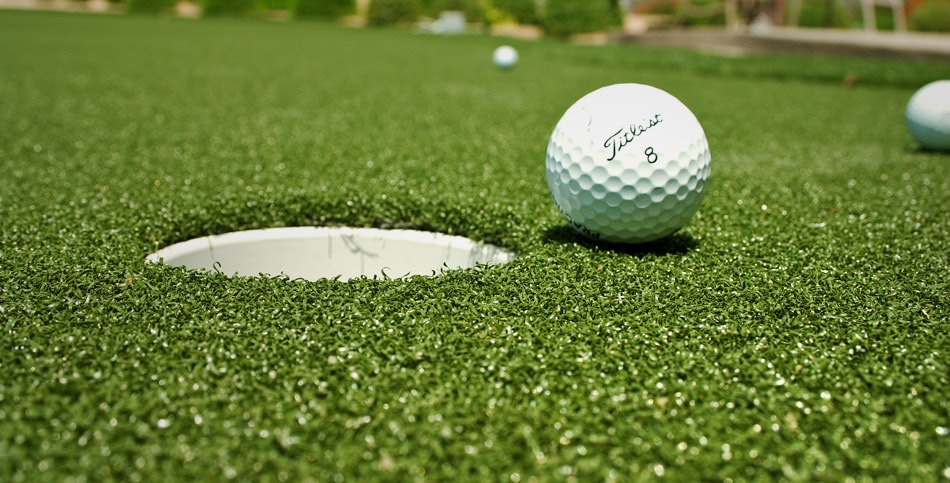Putt from the Green: Differences Between Landing Pages and Website Pages

If you were playing a high-stakes game of golf and you had a choice of where to start, where would you go?
You certainly wouldn’t start in the rough or in the bunker. Would you start at the tee? It’s fun to hit the ball with a driver, but the chances of a hole-in-one are slim.
You would start on the green. The closer to the hole, the better. You want an easy tap in.

When you’re running your marketing campaign and you’re leading prospects back to your website, you want to bring them to the green – or in our case, the landing page.
Unlike a normal webpage where there are so many navigational buttons for you to click, a landing page has a clear goal and only one actionable button.
See the example below, buttons with orange color are actionable buttons:

But just because the action takes place on the landing page doesn’t mean the other pages on your website are useless.
There are differences between landing pages and web pages, but understand that each page on your website has a goal and a purpose.
Lights, Camera, Landing Page!
Web designers make sure that a landing page’s structure, images, and copy come together to encourage a specific behaviour. It’s designed for a visitor to act.
If you’re running a paid search or social campaign or launching a new product you’ll want to direct people to a landing page.
Landing pages are made up of an enticing headline, an accompanying image, a list of benefits, and an effective call-to-action.

From capturing contact information, to entering a contest, to downloading an ebook, landing pages encourage a wide array of behaviours. But each landing page should focus on only one goal.
Home Sweet Homepage
If the landing page is the green, then the homepage is the tee. It’s where most people start to learn about a company. They’ll find information about who you are and what you do. As well as basic information like address, phone number, email, and office hours.
Basic information like these don’t need a strict action-oriented landing page, but adding an opt-in opportunity can be a good source of leads.
When a lead come from a website instead of a landing page, the odds of you turning that person into a client is a lot higher because that prospect has already studied your company carefully instead of just being attracted by your offer or manipulated into performing an action.
Content Pages Tell Your Story
The homepage starts the story, but the content pages take the story into the second act. It’s where the story about a business takes shape, and shares details about the products or services introduced on the homepage.
Content pages continue the conversation and try to answer any questions the visitor may have. The pages are also valuable for search engine optimization (SEO) purposes because more content pages mean your website has more answers.
When a person is looking for answers on search engine, if your competitors do not offer an answer on their website, but yours does, then your website will be shown first.
Here are the types of content pages that a local businss website must have:
- Service Pages – Example
- Purpose: to rank for service keywords, e.g. Kitchen cabinets repainting, monthly search volume: 520
- City Pages – Example
- Purpose: to rank for city + job title keywords, e.g. Burnaby painters, monthly search volume: 260
- Contact Page – Example
- Purpose: for people to contact you.
- About Page – Example
- Purpose: to establish credibility and trust with potential customers
Warning: Building a website with numerous content pages only allows your website to show up for more search queries. However, it does not boost your website ranking. You will need high quality backlinks from pointing to your site in order to show up higher on search results.
Content pages need be optimized for important keywords to gain better rankings as well – you can read more about how we help our clients gain better organic rankings through this article: Recipe To Ranking Your Organic SERPs Better with Coding Bull
If you want to know how you can use multiple content pages as part of a SEO campaign, click the following link: 140 extra service calls for a local plumber in just 1 month!
To get more information about how number of web pages can affect your SEO ranking, check this video out:
Conclusion
If you are running paid ads, a TCB Landing Page is recommended becasue it encourages the user to focus on the offer instead of getting distracted with other information on a website.
If you want to get free traffic from Google, a TCB Performance-Based Website is recommended.
However, If your business only offers 1 service and target 1 service area, then a landing page will suffice. A TCB Landing Page can also be used for organic ranking purposes because it is optimized with CORA – read this article to learn more about CORA (see aspect #2).
Otherwise, leads coming from your website are generally more excited about your brand compared to people who come from your landing page because a website provides more information about your business to them.
